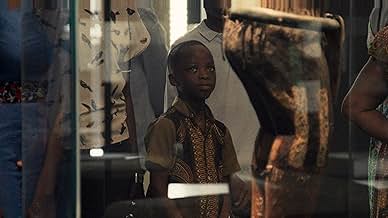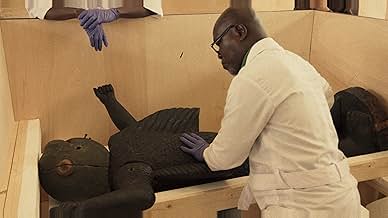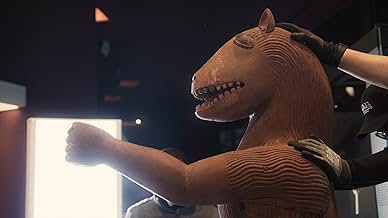Dahomey
- 2024
- 1h 8min
El viaje de 26 tesoros reales expoliados del Reino de Dahomey, expuestos en París, que ahora se devuelven a Benín. Diop expresa artísticamente las reivindicaciones de una nueva generación.El viaje de 26 tesoros reales expoliados del Reino de Dahomey, expuestos en París, que ahora se devuelven a Benín. Diop expresa artísticamente las reivindicaciones de una nueva generación.El viaje de 26 tesoros reales expoliados del Reino de Dahomey, expuestos en París, que ahora se devuelven a Benín. Diop expresa artísticamente las reivindicaciones de una nueva generación.
- Dirección
- Guionistas
- Elenco
- Premios
- 13 premios ganados y 51 nominaciones en total
- Dirección
- Guionistas
- Todo el elenco y el equipo
- Producción, taquilla y más en IMDbPro
Opiniones destacadas
As a viewer from Europe, I felt a slight lack of explanation about what modern Benin is like beyond its capital, which would have helped form an opinion on the discussions presented by the Beninese in the film. However, it's clear that the filmmaker did not set out to provide a comprehensive overview of the country's current state.
Diop's approach is interesting as it felt like a real-life poetry being at displayed. Filled with gorgeous sound designs, music, and interesting imagery choices to present, it's definitely a documentary that sheds a good light on it's way. Interconnected with poetic dialogue, it's slow and meditative approach creates an interesting experience.
It isn't a standard documentary as it's more of an experimental art piece of a movie at times. But it's definitely an interesting experience.
Listening to Beninese talk about the significance of gaining these pieces back and all of the relics still in France was the meatiest part of this film and the most engaging for me. Often, I feel that a unsubstantial film could be edited for improvement. In this case, I feel that a lot of substance could have been added.
I am now perfectly aware that more countries acted similarly in their colonies. In hindsight I should have known better: names like Ivory Coast and Gold Coast are given for a reason to some parts of Africa. Since then, it stayed on my radar, knowing that the inhabitants at the time were not properly paid for those locally made handicraft, nor for mining materials coming out of their soil. Since then, I see contemporary movements to return those artifacts to the original countries, things I was less aware of before.
(Along the same line are parallel movements to offer excuses for past misdeeds around grabbing men and women from African countries, shipping them under harsh circumstances over the ocean, and letting them work under even so harsh conditions without proper pay. It seems a different matter, but it comes forth from a similar abuse of power over former colonies, accompanied by a condescending attitude against other races, and supported by the church, e.g. Pope Nicolaas V writing Dum Diversas in1452.)
It is easy to blindly applaud the return journey of 26 artefacts, going back from Paris to Benin (as the country is called nowadays). This is what we witness in the first half of the documentary. Rather than applauding France's generosity to facilitate this return journey, the 2nd half of this movie shows that it is by far not the last word. Firstly, there is the fact that merely 26 artefacts are just a small fraction of the thousands taken away in past centuries.
Secondly, there is much more to it, like their native languages and cultures that were "stolen" in the past, by actively suppressing all dialects and forcing everyone to speak French, the language of the ruling colonial country France. The current generation in Benin demonstrates this in open discussions on the matters at hand.
All in all, this movie is a welcome contribution to our social perception, at least to mine. It worked for me as an eye opener, broadening the scope of how we utilized our colonies, not only by taking away their natural riches but also by suppressing their local culture.
The narrative use of "26," the artifact that serves as the story's guide, is one of Diop's masterstrokes. Giving a statue its own voice-imbued with a subjective and almost spiritual perspective-turns the narrative into something profoundly human and, paradoxically, otherworldly. The statue's low, wise voice leads us through its journey of displacement, capture, and eventual reconnection. When we see the world through "26's" eyes-like in the scene where light fades as it's packed into a box-we feel the symbolic weight of being stripped of one's roots and confined to a foreign space.
Diop's cinematography is another standout feature. She skillfully balances the grandeur of Benin's landscapes with intimate shots of hands touching, holding, and carrying the artifacts. Every movement captures not just the object itself but the emotional and spiritual bond between the people of Benin and their cultural heritage. This visual duality creates a rhythm that feels almost meditative, giving the audience time to reflect on the depth of loss these artifacts represent-and the powerful act of their return.
Yet "Dahomey" doesn't stop at celebrating restitution as a triumphant event. The film honestly and thoughtfully explores the conversations sparked within the community as the artifacts are brought back. The joy of their return is intertwined with deeper questions: What exactly was lost? Can the void left by centuries of cultural colonialism ever be filled? While some voices express optimism about reclaiming these objects, others question the impact on a history that has been fractured and reshaped by foreign hands. Diop wisely observes these discussions without passing judgment, allowing the viewer to absorb the layers of meaning embedded in every exchange.
At just 68 minutes, the film might leave some viewers feeling like there's more to uncover. The conversations are so rich that a deeper dive would have been welcome. Still, this brevity is part of "Dahomey's" impact: it leaves you wanting to continue the dialogue, both internally and with others. The film doesn't offer easy answers or definitive solutions. Instead, it invites ongoing reflection on the intersection of history, identity, and justice.
"Dahomey" is a brilliant example of how cinema can serve as a tool for resistance and reconstruction. Diop doesn't just document a historic moment-she transforms it into a sensory and intellectual experience that reverberates far beyond the screen. The pain of colonialism is palpable, but so is the hope for a more just future, where stolen stories can be reclaimed and retold by those to whom they truly belong. This is a film that demands attention, reflection, and, above all, action. A work of art that reminds us the fight for historical justice is both a collective and deeply personal act.
¿Sabías que…?
- TriviaOfficial submission of Senegal for the 'Best International Feature Film' category of the 97th Academy Awards in 2025.
- Citas
[first lines]
Voice of Artifact #26: As far back as I can go, there has never been a night so deep and opaque. Here, it is the only possible reality. The beginning and the end. I journeyed so long in my mind but it was so dark in this foreign place that I lost myself in my dreams, becoming one with these walls. Cut off from the land of my birth as if I were dead. There are thousands of us in this night. We all bear the same scars. Uprooted. Ripped out. The spoils of massive plundering. Today, it's me they have chosen like their finest and most legitimate victim! They have named me 26. Not 24. Not 25. Not 30. Just 26.
Selecciones populares
Detalles
Taquilla
- Total en EE. UU. y Canadá
- USD 100,959
- Fin de semana de estreno en EE. UU. y Canadá
- USD 25,960
- 27 oct 2024
- Total a nivel mundial
- USD 593,052
- Tiempo de ejecución1 hora 8 minutos
- Color
- Mezcla de sonido
- Relación de aspecto
- 1.78 : 1
Contribuir a esta página




















